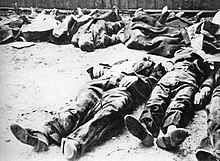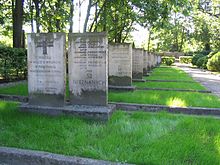Wola massacre
This article needs additional citations for verification. (August 2011) |

The Wola massacre (Polish: Rzeź Woli, "Wola slaughter") (5 – 8 August 1944 in Wola, Warsaw) was the systematic killing of 40,000[1] to 100,000[2] people by Nazi German troops during the Warsaw Uprising in 1944. Polish civilians along with captured resistance fighters were indiscriminately shot or killed in organised mass executions throughout Wola in Warsaw.
The action was designed to crush the Poles' will to fight and put the uprising to an end without having to commit to heavy city fighting.[3] According to Timothy Snyder, "The massacres in Wola had nothing in common with combat. ... The ratio of civilian to military dead was more than a thousand to one, even if military casualties on both sides are counted."[4] However, the Germans soon found that the atrocities in Wola only stiffened Polish resistance and the Germans authority over the city was only achieved after more than two months of heavy fighting and the total destruction of Warsaw.
Uprising


On 2 August, two days after the start of the fighting in Warsaw, SS General Erich von dem Bach-Zelewski was placed in command of all German forces in Warsaw. By then several parts of the city were now held by units from the Polish Home Army. Following direct orders from SS-Reichfuhrer Heinrich Himmler to show no mercy, his strategy was to use terror tactics against all inhabitants of Warsaw to decisively end the uprising and destroy the Poles will to fight.[3] No distinction would be made between Polish insurgents and civilians.
Mass killings
On 5 August, three attack groups started their advance westward along Wolska and Górczewska streets toward the main East-West communication line of Jerusalem Avenue. The German forces were comprised of units from the Wehrmacht and the SS Police Battalions, as well as the S.S. Sturmbrigade R.O.N.A. and the SS-Dirlewanger Brigade. The cadre from this infamous unit, led by Oskar Dirlewanger, was formed from military prisoners, POWs and criminals including rapists, child molesters, murderers and those committed to asylums for the criminally insane.
Shortly after the advance had started towards the center of Warsaw, the three attack groups were halted by heavy fire from Polish resistance fighters. Unable to proceed forward, some of the German troops began to go from house to house carrying out their orders to shoot all inhabitants. Many were shot, but some were killed after torture and sexual assault. Estimates vary, but on the first day of the operation to crush the uprising in Warsaw on August 5, it is believed that up to 10,000 civilians were killed in the Wola district. Most of the victims were the elderly, women and children. Patients along with doctors and nurses were also killed and burned alive when the Nazi units destroyed two local hospitals. [5] The worst atrocities were committed by forces under the command of SS-Oberführer Oskar Dirlewanger and SS-Brigadeführer Bronislav Kaminski, who commanded the S.S. Sturmbrigade R.O.N.A..[6][7][8]
More than fifteen thousand Polish civilians had been murdered by German troops in Warsaw. At 5:30 that evening, General Erich von dem Bach gave the order for the execution of women and children to stop. But the killing continued of all Polish men who were captured, without anyone bothering to find out whether they were insurgents or not. Nor did either the Cossacks or the criminals in the Kaminsky and Dirlewanger brigades pay any attention to von dem Bach Zelewski's order: by rape, murder, torture and fire, they made their way through the suburbs of Wola and Ochota, killing in three days of slaughter a further thirty thousand civilians, including hundreds of patients in each of the hospitals in their path.[9]
By August 6 the Polish resistance, comprising Batalion Zośka and tanks belonging to a unit commanded by Wacław Micuta, managed to capture the ruins of the Warsaw Ghetto and the Warsaw concentration camp. The area became one of the main communication links between the Polish fighters holding Wola and those defending the Warsaw Old Town.
On 7 August 1944, the German ground forces were strengthened with tanks. To enhance their effectiveness, the Nazis forced civilain women onto the armoured vehicles as human shields.[10] Within two days, the tactics had helped the Germans fight their way to the Plac Bankowy and cut the Wola district in half.
On August 12, the order was given to stop the indiscriminate killing of Polish civilians. General von dem Bach issued a new directive that stated captured civilians were to be sent to concentration camps or to Arbeitslager. Other Polish civilians were formed into Verbrennungskommando ((Burning Detachments)) by the SS and forced to hide evidence of the massacre by burning victims' bodies and their homes. [11]
Estimates of civilians killed in Wola and Ochota range from 20,000 to 50,000.[12] But up to 40,000 people are believed to have been murdered in Wola by 8 August. [13] However recent research in Poland suggests the number of victims could be as high as 100,000.[14]
Aftermath

Up until mid September, the Nazis were shooting all captured insurgents on the spot. After SS-Obergruppenführer Erich von dem Bach arrived in Warsaw (7 August 1944), it became clear that atrocities only stiffened the resistance and that some political solution should be found, considering the limited forces at the disposal of the German commander. The aim was to gain a significant victory to show the Armia Krajowa the futility of further fighting and make them surrender.
This did not immediately succeed, but from the end of September on, some of the captured Polish fighters were treated as prisoners of war and civilians were spared, and in the end the districts of Warsaw still held by insurgents capitulated on 3 October 1944.
The main perpetrators were Heinz Reinefarth and Oskar Dirlewanger, who presided over the most cruel atrocities. Dirlewanger was tortured to death by Polish military guards after the war, but Reinefarth was never prosecuted. A list of several former Dirlewanger members still alive and never prosecuted was made by the Warsaw Uprising Museum in May 2008.[15] After the end of the war, no German soldier involved in the Wola and Ochota massacres during the Warsaw Uprising was prosecuted for their crimes.
See also
- List of massacres in Poland
- Military description of the Warsaw Uprising
- Nazi crimes against ethnic Poles
- Ochota massacre – August 1944 atrocities in Ochota district of Warsaw, committed mostly by Russian collaborators led by Bronislaw Kaminski
References
- ^ Muzeum Powstania otwarte, BBC Polish edition, 2 October 2004, Last accessed on 13 April 2007
- ^ Template:Pl icon O Powstaniu Warszawskim opowiada prof. Jerzy Kłoczowski, Gazeta Wyborcza – local Warsaw edition, 1998-08-01. Last accessed on 13 April 2007
- ^ a b THE SLAUGHTER IN WOLA at Warsaw Uprising Museum
- ^ Timothy Snyder, Bloodlands: Europe Between Hitler and Stalin, page 304
- ^ Lukas, Richard (1997). Forgotten Holocaust. The Poles under German Occupation 1939-1944. Hippocrene Books, New York. ISBN 0-7818-0901-0.
- ^ "Warsaw Uprising of 1944: PART 5 – "THEY ARE BURNING WARSAW"". Poloniatoday.com. 5 August 1944. Retrieved 3 February 2009.
- ^ "The Rape of Warsaw". Stosstruppen39-45.tripod.com. Retrieved 3 February 2009.
- ^ Zaloga, Steven J. & Richard Hook (1982). The Polish Army 1939–45. Osprey Publishing. p. 25. ISBN 0-85045-417-4.
- ^ Gilbert, Martin (2004). [http://books.google.com/books?ie=UTF-8&hl=en&id=Y_sfOn8BkOwC&pg=PA565&lpg=PA565&dq=wola+warsaw&prev=http://books.google.com/books%3Fq%3Dwola%2Bwarsaw%26lr%3D%26start%3D20&sig=0fzvAMxrwRolIgZBDRR69Lkpo9U The Second World War: A Complete History. Owl Books. p. 565. ISBN 0-8050-7623-9.
{{cite book}}: External link in|title= - ^ "1944: Uprising to free Warsaw begins". BBC News. 1 August, 2002.
{{cite news}}: Check date values in:|date=(help); Italic or bold markup not allowed in:|publisher=(help) - ^ "Timeline". Warsaw Uprising. Retrieved 3 February 2009.
- ^ Davies, p. 252.
- ^ Template:Pl icon "Muzeum Powstania otwarte". BBC Polish edition. 2 October 2004.
- ^ Template:Pl icon Jerzy Kłoczowski (1 August 1998). "O Powstaniu Warszawskim opowiada prof. Jerzy Kłoczowski". Gazeta Wyborcza (Warsaw ed.).
- ^ Odkryta kartoteka zbrodniarzy, Rzeczpospolita, 17 May 2008
External links
- Waffen-SS im Einsatz: The Rape of Warsaw
- Witness testimony on German massacre of Polish hospital patients
- Witness testimony on German massacre of Polish civilians in Wola
- Template:De icon Nacht über Wola, Der Spiegel
